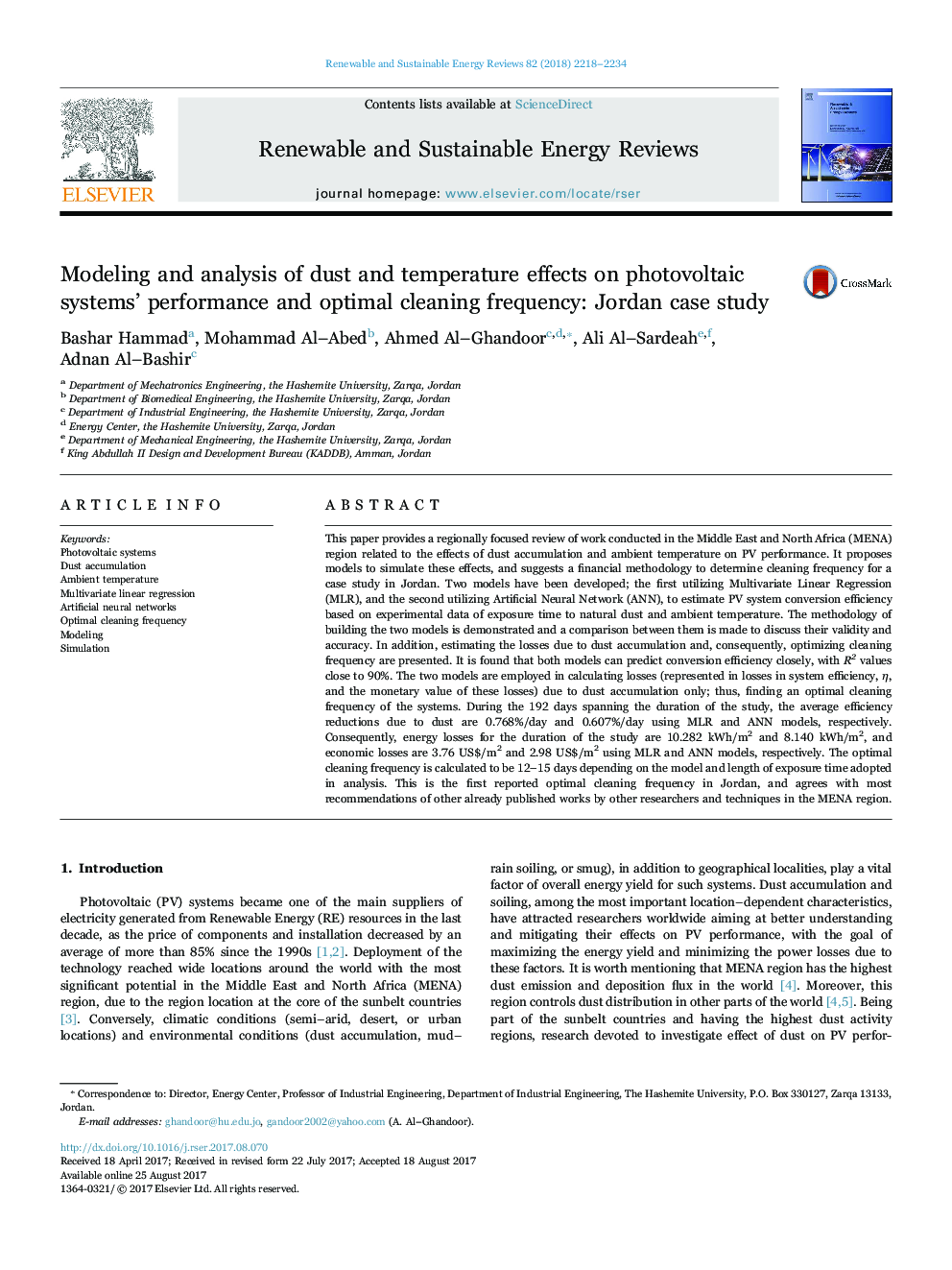| کد مقاله | کد نشریه | سال انتشار | مقاله انگلیسی | نسخه تمام متن |
|---|---|---|---|---|
| 8111767 | 1522302 | 2018 | 17 صفحه PDF | دانلود رایگان |
عنوان انگلیسی مقاله ISI
Modeling and analysis of dust and temperature effects on photovoltaic systems' performance and optimal cleaning frequency: Jordan case study
ترجمه فارسی عنوان
مدلسازی و تجزیه و تحلیل اثرات گرد و غبار و دما بر عملکرد سیستم های فتوولتائیک و فرآیند تمیز کردن بهینه: مطالعه موردی اردن
دانلود مقاله + سفارش ترجمه
دانلود مقاله ISI انگلیسی
رایگان برای ایرانیان
کلمات کلیدی
سیستم های فتوولتائیک، تجمع گرد و غبار، دمای محیط، رگرسیون خطی چند متغیره، شبکه های عصبی مصنوعی، فرکانس تمیز کردن بهینه مدل سازی، شبیه سازی،
موضوعات مرتبط
مهندسی و علوم پایه
مهندسی انرژی
انرژی های تجدید پذیر، توسعه پایدار و محیط زیست
چکیده انگلیسی
This paper provides a regionally focused review of work conducted in the Middle East and North Africa (MENA) region related to the effects of dust accumulation and ambient temperature on PV performance. It proposes models to simulate these effects, and suggests a financial methodology to determine cleaning frequency for a case study in Jordan. Two models have been developed; the first utilizing Multivariate Linear Regression (MLR), and the second utilizing Artificial Neural Network (ANN), to estimate PV system conversion efficiency based on experimental data of exposure time to natural dust and ambient temperature. The methodology of building the two models is demonstrated and a comparison between them is made to discuss their validity and accuracy. In addition, estimating the losses due to dust accumulation and, consequently, optimizing cleaning frequency are presented. It is found that both models can predict conversion efficiency closely, with R2 values close to 90%. The two models are employed in calculating losses (represented in losses in system efficiency, η, and the monetary value of these losses) due to dust accumulation only; thus, finding an optimal cleaning frequency of the systems. During the 192 days spanning the duration of the study, the average efficiency reductions due to dust are 0.768%/day and 0.607%/day using MLR and ANN models, respectively. Consequently, energy losses for the duration of the study are 10.282 kWh/m2 and 8.140 kWh/m2, and economic losses are 3.76 US$/m2 and 2.98 US$/m2 using MLR and ANN models, respectively. The optimal cleaning frequency is calculated to be 12-15 days depending on the model and length of exposure time adopted in analysis. This is the first reported optimal cleaning frequency in Jordan, and agrees with most recommendations of other already published works by other researchers and techniques in the MENA region.
ناشر
Database: Elsevier - ScienceDirect (ساینس دایرکت)
Journal: Renewable and Sustainable Energy Reviews - Volume 82, Part 3, February 2018, Pages 2218-2234
Journal: Renewable and Sustainable Energy Reviews - Volume 82, Part 3, February 2018, Pages 2218-2234
نویسندگان
Bashar Hammad, Mohammad Al-Abed, Ahmed Al-Ghandoor, Ali Al-Sardeah, Adnan Al-Bashir,
